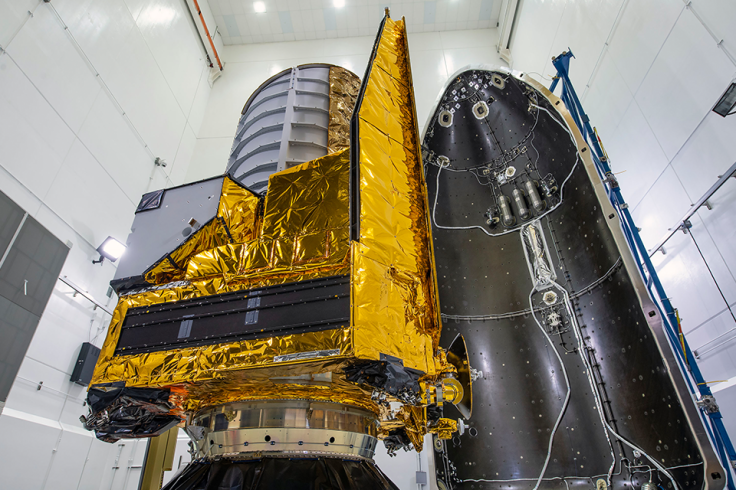Euclid space telescope to investigate the mysteries of the 'dark universe'
The Euclid space telescope will embark upon a six-year mission to observe billions of galaxies, enabling scientists to understand the role of dark matter and dark energy within the cosmos.

Given its inconceivably vast nature, the observable universe is a source of many scientific mysteries. In our galaxy, the Milky Way, there are at least 100 billion stars that co-exist alongside our sun. The Milky Way galaxy spans 100,000 light-years from one end to the other.
If that wasn't hard enough to get your head around, consider the number of galaxies in the universe. Given that we don't know exactly how big the universe is, scientists don't know exactly how many galaxies there are. However, estimations range from 100 to 200 billion all the way up to two trillion.
In the history of cosmology, scientists have uncovered answers to many of the mysteries of the universe. For example, the age of the universe has been estimated at 13.77 billion years using data provided by the Wilkinson Microwave Anisotropy Probe, which was launched in 2001. The probe's data also enabled scientists to discover that only 4.6 per cent of the universe is made up of atoms. The remaining 95.4 per cent of the universe is comprised of dark matter and dark energy.
Crucially, the first of July 2023 marked an important date in the history of science and cosmology. Launched using the SpaceX Falcon 9 rocket, the Euclid space telescope will explore the composition and evolution of the dark universe.
The European Space Agency (ESA) is responsible for leading the Euclid mission, which consists of a consortium of 2,000 scientists across 16 countries. The experts of the wider Euclid consortium come from 300 organisations across 13 European countries, in addition to the US, Canada and Japan.
Britain's Secretary of State for Science and Technology Chloe Smith has referred to Euclid's launch as "a truly significant moment." She also referred to the "remarkable scientific talent and expertise" that Britain has contributed to the mission. Indeed, Britain is a competitive destination globally for space investment.
In the words of Professor Mark Thomson, Executive Chair at the Science and Technology Facilities Council (STFC): "Euclid will answer some of the biggest and most profound questions we have about the Universe and dark energy."
Contributing to the design and development of Euclid's instruments, the STFC is one of the research councils which comprises UK Research and Innovation (UKRI).
The significance of Euclid is also conveyed by Dr Paul Bate, Chief Executive of the UK Space Agency, who has explained that the space telescope "will help humanity begin to uncover the mysteries of dark matter and dark energy". In other news, the UK Space Agency is investing in space technologies through the Enabling Technologies Programme.
Euclid will explore the dark universe by observing "billions of galaxies out to 10 billion light-years, across more than a third of the sky" to create "a great map of the large-scale structure of the Universe".
Dr Seshadri Nadathur, a Senior Research Fellow at Portsmouth's Institute of Cosmology and Gravitation, believes "galaxies are not randomly scattered around the sky."
On the contrary, he went on to explain: "There are patterns in their positions that are relics of correlations created at the time of the Big Bang." These patterns are "shaped over billions of years" with "gravity pulling galaxies together" on one hand, and "the expansion of the Universe driving them apart", on the other.
Crucially, Dr Nadathur explains that the maps created by Euclid will enable scientists to measure and understand these patterns, shedding light on "the mysterious force of dark energy that seems to be driving the Universe to expand ever faster".
The Euclid probe will utilise two scientific instruments on its six-year mission in space. A British-built visible imager (VIS) and a French-built near-infrared spectrometer and photometer (NISP).
Referring to the VIS, Smith has explained: "The mission will launch one of the largest cameras ever into space to look out across our universe." Crucially, VIS gives Euclid the capacity to make detailed images of galaxies "over a much larger fraction of the sky than would be possible from the ground".
NISP gives Euclid the capacity to make "spectroscopic measurements of galaxies" which reveal the amount of light they emit per wavelength. According to the ESA: "This is useful for measuring the galaxies' redshift, which cosmologists can use to estimate the distance to each galaxy."
Euclid has been backed by £37 million worth of UK Space Agency funding. According to Dr Paul Bate, the investment from the UK Space Agency has helped develop the ground segment as well as the "crucial visible imager instrument".
The funding, which dates back to 2010, has been distributed amongst teams at several British universities. The largest amount of funding (£20.5 million) was given to University College London, where researchers have designed, built, and tested the VIS optical camera. A further £8.9 million was used by the University of Edinburgh to lead "the Euclid gravitational lensing data analysis".
The Department of Physics at the University of Oxford has also contributed to the development of "lensing data analysis". According to Professor Lance Miller who leads work on Euclid at Oxford, "the finishing touches" are being applied "to the software that will be analysing some of the first Euclid data sent back to Earth, from August onwards".
The team at the University of Portsmouth has been creating code to "analyse data from the spacecraft". According to Dr Nadathur, the team at Portsmouth is working to develop and test software which corrects for "spurious patterns in the galaxy positions" that are caused by "variations in the performance of the telescope and instruments". This means that "true cosmological patterns" can be identified.
© Copyright IBTimes 2025. All rights reserved.





















